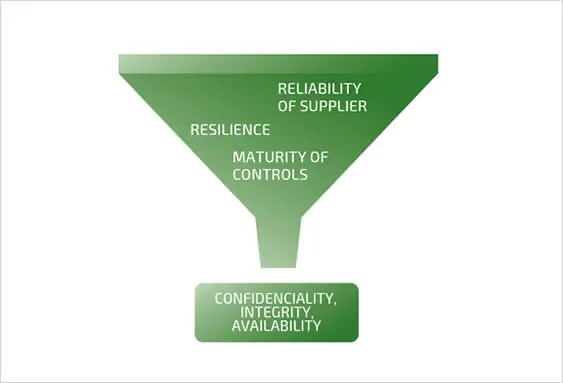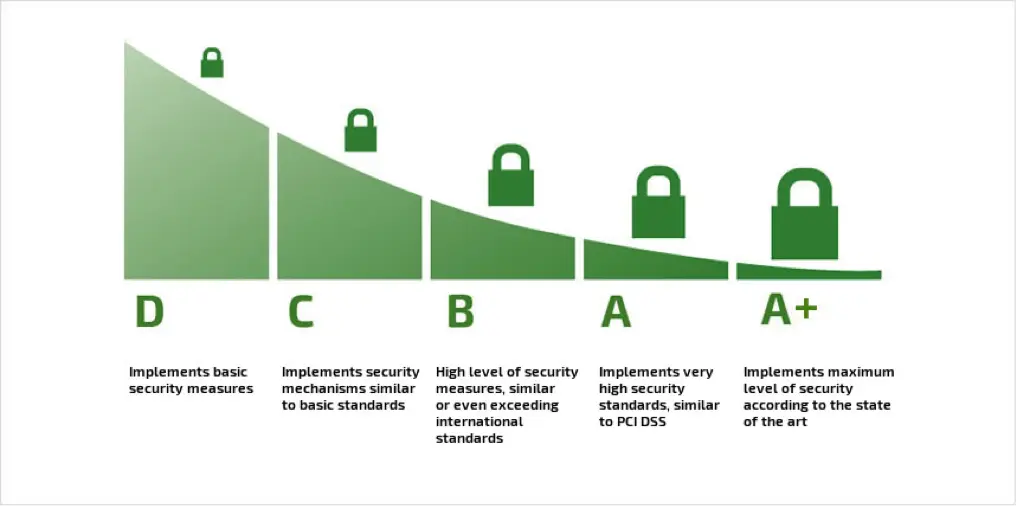Do business safely
A rigorous and transparent security labelling methodology
The rating guide reflects in detail the procedures and more than 1300 practices which are analyzed to determine the rating of the security levels provided by suppliers in each service.
The model is based on a supervised self-declaration, which means that it is the ICT service provider itself which chooses the level where it wants to rate their service, and it must complete a memory defining how it meets the practices required for that level, which is audited by LEET Security to verify that the proposed level is adequate.
The rating methodology is the first system that adeheres to the standard "UNE 71381:2016 Information technology. Cloud Computing. Labelling systems" that defines the requirements for labelling systems, like LEET Security.

Procedure
The procedure, following acceptance of the conditions by the supplier, is developed in the following phases:
Score
The ratings consist of 3 letters, which define the level of qualification obtained by the supplier for the particular service on the three fundamental dimensions of Confidentiality, Integrity and Availability of information. All grades are registered and published on the website of LEET Security and through its diffusion channels.
Both, the specific measures implemented by qualified service provider, as the general characteristics of the supplier, are taken into account to grant these rating levels and to ensure that it is a reliable supplier and finally implements measures to ensure resilience served (because given the fact that no one is immune to an incident, the most important thing is to assess the resilience of the service).

Follow up
The follow-up to ensure that the required conditions are maintained during the period of validity, is performed based on three additional control mechanisms:
Perform random audits.
Digital surveillance, including incident/compain notification channel for users of rated services.
Obligation for the provider to notify LEET Security about any circumstance or modification that may affect the rating.
In either case, LEET Security would proceed with a reassessment in order to determine whether maintenance or modification of the rating levels granted to the service.
Rating levels
All the practices included in the rating guide are classified into 5 levels, from A+ to D; the 'D' level already demands meeting basic safety measures and corresponding to level 'A+' for best possible package os measures at the current time. Thus, the “A+” level' is reserved for those services that manage highly confidential information (such as industrial or national secrets) or very stringent availability requirements (such as critical infrastructures).
To achieve a certain level you must meet all the practices required for the same, based on the maxim that "security is only as strong as its weakest link". This implies that if a service complies with all necessary practices to achieve the level B, except for one, which reaches practices for level C, the final grade will be a C.

By displaying the LEET stamp, the provider guarantees that the qualified service implements a management system and security mechanisms.
This score is not global; relevant measures for the three fundamental dimensions of information security are evaluated: Confidentiality, Integrity and Availability. Thus, the rating assigned by LEET Security consists of three letters: the first indicates the reliability of service in terms of the Confidentiality, Integrity is assessed by the second and the third measures the availability, always provided specifically for the qualified service.
Our rating system has also established special levels for different standards. In this version of the methodology there are six special complementary compliance qualifiers:
+DORA (DORA Passport) indicates the degree of compliance with the requirements established by the European DORA (Digital Operational Resilience Act) regulation. It includes a cyber resilience index, indicating the degree of implementation of cyber resilience measures, between 0 and 1000, on two levels, DORA Prime (between 500 and 749) and DORA Elite (between 750 and 1,000).
+NIS2 (NIS2 Passport) provides a comprehensive assessment of the requirements set out in the Regulation NIS2
+PRIV, is awarded after verification of compliance with all practices linked to data protection regulations, and in particular with the General Data Protection Regulation and the LOPDGDD, in accordance with the level of qualification obtained.
+C4V, indicating compliance with the Cybersecurity Capacity Building model for the Value Chain, in accordance with the ENSI
+ENS/c, indicating compliance with RD 311/2022, which regulates the National Security Scheme.
+PCI, implying that the service complies with PCI DSS v3.1.
You can also meet the nonspecific rating: PASSED. This means that the service at least meets all controls relevant to Level D in the three dimensions, although the provider does not want to show levels explicitly. In this case, the executive summary of the levels can be consulted in the section of qualified services, associated with the respective registry number, or access it by clicking on the stamp shown on the website of the service provider.
Appreciation:
LEET Security’s rating system, developed since 2010 and continually evolving, is recognized by the European Agency for Network and Information Security (ENISA) and Instituto Nacional de Ciberseguridad (INCIBE), as trust mechanism..



